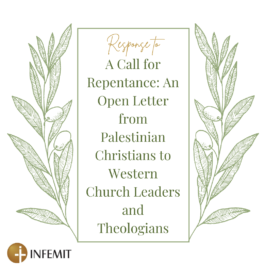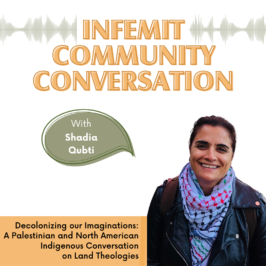English transcript
I would like to extend my sincere thanks to International Fellowship for Mission as Transformation for inviting me to make a presentation on the theme, “Peace Building and Conflict Transformation from a lens of Postcolonialism and Indigenous Christianity.” This presentation has three parts. In part one, I invite you to listen to the conflict realities of indigenous communities from India. In part two, we will look at Triple Colonization of Indian Bible Women on the basis of caste, race, and patriarchy. Under this subheading we will be looking at Native Indian women as powerful colonial Intermediaries. We will take a specific case of Triple colonization of Native Dalit Bible women in South Travancore, that is the southernmost part of India, in late 19th century. And in the final part we will look at Jesus’ movement, peace building, and conflict transformation. We will see how Jesus approached the Jewish communities, especially the colonized Jewish communities, and the way he acted to protect their rights helps us to understand how Jesus intervened in a situation of conflict. The way Jesus resisted Jewish leaders leads to protest to native elites who supported Roman imperialism. Jesus sustained his struggle until his death on the cross. We will look in detail how his struggle against Roman Imperialism was done and how that can be a model to us in our struggle against powers of domination today.
Part 1- Listening to the Conflict Realities of Indigenous communities from India
India’s social hierarchy of casteism places people under four major categories (chaturvarna) such as Brahmins, Kshatriyas, Vyshias, and Shudras right within the system and one category outside the system, who are called the dalits. About 16 percentage of Indian population is comprised of dalits. They are at the brunt of discrimination, due to their outcaste identity, varying from denial of access to nutrition, education, employment and upward social mobility. Their designation to particular menial jobs in India include managing graveyards, disposing of dead animals, leather workers, street sweepers, cobblers, and landless agricultural workers.
Many Dalits are impoverished, uneducated, and illiterate. Dalits form the majority of bonded laborers. Dalits have been socially oppressed, culturally subjugated, and politically marginalized. The purity-pollution binary underlies all the socio-cultural and political discrimination dalits face in India. It is shameful that conversion to Christianity has not guaranteed emancipation from this Hindu religious practice of caste system.
Brahmanism, as a hierarchical ideology, exposes its ugly manifestation both as philosophy of life and social order. B. R. Ambedkar has long back identified the philosophy of Brahmanism as predominantly responsible for pushing the dalits and shudras into a degraded social status devoid of hope and ambitions. For him, Brahmanism is guided by:
Primarily, 1) graded inequality between the different classes, 2) complete disarmament of the Shudras and the Untouchables, 3)complete prohibition of the education of the Shudras and the Untouchables, 4) ban on Shudras and the Untouchables occupying places of power and authority, 5) ban on the Shudras and the Untouchables acquiring property and 6) complete subjugation and suppression of women.
Brahmanism’s hold on education of dalits has been checked to a certain extent through making education accessible through constitutional rights, however, Brahmanism continues to propagate inequality, disarmament, prohibition to power and authority, ban on acquiring property and complete denial of agency of women. Brahmanism is not just against equality, but it preaches graded inequality, which is evident from grouping people into chaturvarna and excluding a group of people (dalits) in the very same unequal stratification on the basis of outcastes. When people are grouped into caste identity by birth, without any room for change or access to power to change, it creates a pathological system of unjust social order.
Brahmanism, in modern India, represents the caste ideology intersecting with class and gender identities. Patriarchy, casteism, and Classism existed in pre-colonial India and it was not surprising when the native elites, here the aristocratic Brahmin males, joined hands with the colonial authorities to retain power structures intact. The colonial period witnessed the hegemonic collaboration of casteist Indian elite men and racist imperial (be Portuguese, Dutch, French or British) foreign rulers.
It was during British colonization of India that the missionary agencies strategically shared imperial values in their missionary agenda. It happened mainly to retain their own survival in a British colony as well as for monetary support from well wishers back in England. In this process, White missionaries from England since 18th century have failed to address the dominant oppressive systems that were already in operation such as casteism and patriarchy. Therefore, while White missionaries introduced Bible and interpretative methods, they were categorically foreign culturally biased against the natives as well as reiterating the native hierarchies. Such interpretations failed to employ critical lenses to view casteism in colonial period, thus favoring native cultural and social evil practices.
Dalit politics is an attempt to politicize the existence of dalit communities, identifying themselves as members of a political and ethical community. The unique disabilities of untouchability have demanded specific modes of politicizing the ethical existence of dalits in India. When Brahmanism is viewed through colonial past of India, one would invariably encounter its contribution toward creating spaces for dalit politics. But this had happened through complex phenomena of colonial association with Hindu religion and secularization of caste. Colonial powers have renounced their mediating in religious rights and communal standing, thus challenged caste discipline and brahmanic norms.
However, the various exclusionary mechanisms embedded in hierarchical social stratification have categorically kept dalits from accessing power to overcome extreme underprivileged situations, minimal decision making and inaccessibility to political endeavors of identity formation.
Native Indian Bible Women: A Powerful Colonial Intermediary?
Moving to the second part of the presentation where we will look at Native Indian Bible Women as powerful colonial intermediaries. “Women had an ideological role to play in colonialism as guardians of the ‘race’, in face of moral panics about miscegenation or compromising the perceived ‘purity’ of the European woman and these fears have also had an impact on the depiction of the non-European colonized woman.” It was in such a complex context of retaining “European identity” or “European purity” that the European women missionaries initiated their ministry among native Indian women. Indian Bible women, are the initial products of their missionary activities, who became the mediators between the local women and the missionaries.
Originally initiated as the “women’s work” of the wives of missionaries of London Missionary Society in South Travancore, I’m highlighting a particular case here- the women missionaries of London Missionary Society, who came to Southern part of Travancore in 19th, in 18th century. Their work among women began to expand by recruiting single women as missionaries of England, breaking through “the confining domestic world of married women” who later outnumbered even the male missionaries. That’s very interesting. Another way of pushing White women’s colonial identity was to break the image of “the mothers of the missionaries” or even wives of the missionaries to an active agent in the mission movement by initially starting a school for native Indian girls. Moving away from being part of their husbands’ missionary role, White women missionaries started establishing their own identity as independent and active agents by such appeals for native Indian women’s education. While White women missionaries found freedom from their patriarchal bondages, it was further oppressive for native Indian women. Their oppression could be understood in terms of triple colonization on the basis of race, caste and gender. Caste is an addition that was left out in the formulation of “double colonization” by the African women in 1980s, as this is an additional burden of internal apartheid for Indian women. This is evident in the rationale provided for introducing women missionaries in London Missionary Society. I quote here, “the aim of female education was to produce the good wives and mothers deemed essential if the converts of the male missionaries were to establish solid Christian families and communities as the critical [bulwark] against ‘heathenism’.” Here heathenism could mean to all the social evils of Hinduism, which held native women under the bondage of caste and patriarchy in various forms, such as child marriage, widow immolation, and denial of right of the “low caste” Channar (Nadar) women to wear upper cloth or jacket or the right to cover their breasts.
The public/private space, or sphere divide, is evident in the analysis of gender and colonialism where it is assumed that colonising and colonised women are confined to the private domestic sphere, while colonising and colonised men operate in the public sphere. However, experiences of colonised women in their native land and that of colonising women in their foreign colonies are certainly different. Sara Mills comments, “…British women’s travel writing in colonised countries, together with the accounts of British women in outpost situations, by their very presence alone in the public sphere destabilise notions of a clear female-private/male-public sphere divide. The ruling or dominant voice in the society decides what a norm in relation to gender and space could be. When the dominant one is a political invader, then, their culture is treated as superior to the native culture and gender gets alienated in the resulted power discourses. Different groups of women and men have different experiences in a power dominant colonial situation. Different times of history have also played a vital role in establishing varying degrees of hegemony of men and women in the binary context of public/private divide. As far as the Women missionaries of LMS, that is London Missionary, Society, were concerned, their active role in the evangelistic as well as social mission to native Indian women opened up new vistas of blurring the boundaries between public and private spheres. However, that could not guarantee them freedom to dismantle the patriarchal notions of British colonialism, which targeted them too in the colonial patriarchy. Further, their marital status also mattered, as married women missionaries remained in the shadow of their husbands, while single women were more forceful in penetrating through the local cultures. In case of native women, they had to fight for fraternity and unity among their native men against colonial powers, nevertheless, their interactions with Women missionaries motivated them to stage public protests, especially as in the case of Upper Cloth Movement. These indigenous women could stage a protest against caste men, and they could fight and gain their right to cover their upper body. And it is not that either private or public is exclusively threatening to women or men in a colonized environment where someone else decides what happens in one’s life. It is least possible to create an ideal space for gender notions when it is intertwined with patriarchal and colonial entanglements.
Now we move over to the part 3, which is:
Jesus’ movement, peace building, and conflict transformation
Majority of the Jewish people in the first century Palestine lived in their own land as aliens and strangers as socially ostracized people in the hierarchical society of Roman imperial rule. Jesus’ movement was a peasant movement to resist the power structures of imperialism and Jewish elitism. Jesus’ confrontation of Jewish authorities who collaborate with Roman imperial powers along with his insistence of Jewish priority in God’s mission clearly set him against Roman imperial agenda. Therefore, by siding with the ordinary people of Palestine, Jesus rejects Roman imperialism along with critiquing the Jewish religious elites who collaborate with hegemonic interests of imperial powers.
During Jesus’ earthly ministry, he sends twelve disciples on a mission journey with a strict command to “Go nowhere among the Gentiles, and enter no town of the Samaritans, but go rather to the lost sheep of the house of Israel.” This is found in Matthew Chapter 10, verse 5. Jesus insists on his Jewish mission again in Matthew 15:24, when he replies to the Canaanite woman that he was sent only to the lost sheep of the house of Israel. In Matthew 10:5 and 15:24, Jesus’ words indicate the Jewish particularism in the sense that they remind readers of God’s exclusive covenant with Abraham.
One may argue that the Jewish particularism is focused on narrow ethnic boundaries of the first century Judaism, however, Jesus’ insistence on Jewish exclusivity in Matthew, specifically in Matthew, is set against the backdrop of them being colonized by Roman imperial powers. Therefore, by taking side with the salvific privileging of the Jews, Jesus is clearly revealing his stance against the rulers in authority. This attitude to Jews changes when Jesus refers to Jewish leaders like Pharisees, Sadducees, chief priests, and scribes. The Jewish leaders’ rejection of Jesus indicates collaboration with Roman imperialism. Why do the Jewish leaders oppose Jesus’ claims of divine intervention in history? The Jewish leaders function as native elites who collaborate with Roman imperial powers to retain their status quo and to benefit from a hierarchically stratified social set up. Jesus did not clash openly with the Roman authorities, but he directed his anger towards Israel’s internal imperialism and the collaborators with the Roman Empire.
Jesus fought imperialism of every sort when he resisted and rejected dominance, and spoke for and worked for autonomy and liberation. Jesus undermined imperialism when he refused to submit or conform to the powers that be, to their prescriptions, their prohibitions and their framework for living; he did it when he encouraged others to refuse too. He was subverting imperialism when he took away people’s fear, and challenged them to think and act independently. One remarkable thing about the Gospels is that each of them is the story of a sustained struggle unto death against dominance by religion, tradition, society, State, and empire.
The well-known Asian theologian Samuel Rayan thinks that Jesus’ rejection of the Roman Empire was not confrontational, for it might have led to defeat of his earthly mission. Nevertheless, one witnesses how he was confrontational to the Jewish leaders.
Therefore, “to fight over interpretations of Torah, for example, is to fight over claims to possess the past and envision present social interaction and structure. To fight with the temple-based Jerusalem leaders is to fight with those who also must negotiate Roman power, allying with it to preserve their own status and power, while selectively representing traditions that are often contestive of imperial power.” This is a statement from Warren Carter. Therefore, Jesus’ attack on the religious authority of Jewish elites is not just an attack on them alone, but also on the hegemony that continually sanctioned their authority in a hierarchical imperial social set up. By critiquing the Jewish leaders who collaborate with the Roman empire, Jesus challenges Roman imperialism.
To conclude, the ethnic particularity of Jews merges with extending mission to nations in Matthew 28:18-20, this is the very familiar term, “Great Commission” that we find in Matthew. Therefore, Jewish particularism merging with the great commission in Matthew 28:18-20 is a postcolonial act, I would say, of including those who were earlier excluded from the mission due to the colonized political situation. The hegemonic stratification of ancient society based on ethnic identities finds accommodation of all in the universal extension of Jesus’ salvific act now through the great commission. In other words, this serves as a, I mean, the great commission, could serve as a postcolonial act since the mission moves beyond the narrow ethnic boundaries of Judaism of the Bible, and all the narrow ethnic boundaries of current times, to accommodate others, to include everyone, who otherwise would have been othered by the exclusive claims of access to God. Thank you very much.






Leave a Reply